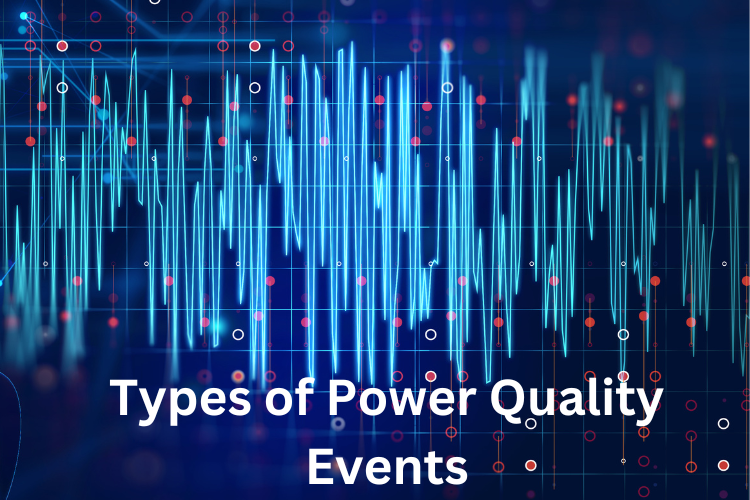Power Quality Solution
Introduction:
Power systems have become polluted with unwanted variations in the voltage and current signal due to the use of nonlinear loads and sensitive electronic equipment. The demand for high-quality power is ever-increasing due to the deregulation of the power industry. Continuous monitoring is required because of the increasing demand for clean power and monitoring standards are also given by the Institute of Electrical and Electronics Engineers (IEEE), recommended practice for monitoring electric power quality.
Power Quality (PQ):
In simple electrical PQ is defined as the quality power having a prescribed range of voltage and frequency. The scientist gives the following definition.
Gerry Heydt defines PQ as “The measure, analysis and improvement of bus voltage, usually a load bus voltage to maintain that voltage to be sinusoid at rated voltage and frequency.”
A PQ problem is defined by Roger Dugan as “Any power problem manifested in voltage, current or frequency deviation that results in failure or missed operation of utility or end-user equipment.”
Types of PQ Events:
The sensitive power electronics load, load variation, switching, sudden loss of heavy load, and interconnectivity of the power system lead to the PQ disturbances. Transients, Long duration voltage variation, short-duration voltage variation, Waveform distortion, Frequency variation, voltage Imbalance, and Fluctuations are the PQ disturbances.
Power quality periodic voltage events are Sag or Dip, Swell, Under-voltage, Overvoltage, Interruption, Flicker, Transient or Surge, and steady-state waveform distortion events are Current Harmonics, Voltage Notching, Voltage Imbalance or Unbalance, and Noise.
1) Voltage Sag (Dip): –
It is a most occurring PQ problem; when the RMS voltage decreases between the range of 10 to 90 percent of nominal voltage for the duration of 0.5 cycles to a few seconds then it is a voltage sag event. It is a short-duration voltage decrease in the range of 0.1 to 0.9 pu.
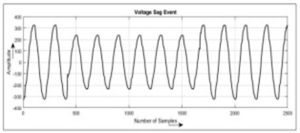
The causes of sag are as follows:
- Short circuits faults
- A sudden increase in load demand
- Inrush Currents
- Operation of reclosing of circuit breakers
- Switching OFF of the capacitor bank.
The effect of voltage sag is the drop in the speed of the induction motor, torque oscillation, and overcurrent. Sensitive electronic equipment gets most affected by voltage sag.
Voltage sag lasting longer than minutes then it’s called Undervoltage.
2) Voltage Swell: –
The voltage swells are usually associated with system fault conditions, but they are much less common than voltage sags; when the RMS voltage increases between the range 110 to 180 percent of nominal voltage for the duration of 0.5 cycles to a few seconds then it is a voltage swell event. It is a short-duration voltage increase in the range of 1.1 to 1.8 pu.
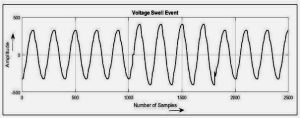
The causes of sag are as follows:
- Single line to ground fault,
- Short circuits switching on or off a heavy load
- Energizing a heavy capacitor bank.
The effects of voltage swell are data loss, a flickering of lighting, and screen damage of sensitive equipment if the voltage values are too high.
Voltage swells lasting longer than minutes then it’s called overvoltage.
3) Transients: –
A transient is a momentary type of event, which are much less than a full cycle oftentimes a one-second or less. Transients are generally classified into two categories: oscillatory (caused by switching on and off a heavy load, capacitor bank energization) and impulsive (caused by lightning strokes).
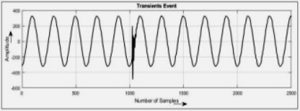
The causes of transients are as follows:
- Switching on and off a heavy load (oscillatory)
- Capacitor bank energization (oscillatory)
- Lightning strokes (impulsive)
Transients come very quickly and go; Computers and other sensitive electronic equipment may be seriously damaged by such a short overvoltage. The temporary fluctuation may produce parity error in the system.
4) Interruption: –
The Interruption is a reduction in supply voltage or current to 0.1 pu. or complete loss of supply voltage for period 0.5 cycles to a few seconds.
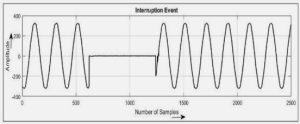
The causes of Interruption are as follows:
- System faults
- Control and protection malfunction
- System equipment failure
Interruption affects all types of equipment in the system.
5) Current Harmonics
For linear load, current follows the voltage waveform, which results from the sinusoidal waveforms. When the nonlinear load is added to the system then it results in distortion of the waveform. Harmonics are the integral multiple of the fundamental frequency. They are classified as Even, Odd, and Triplen.

The causes of current harmonics are as follows:
- Increased use of non-linear circuit elements
- High-frequency, TVs, switches, computers, and fluorescent lightning
- Power factor correction capacitor
- Negligent users unaware of signal pollution generated by equipment
Current harmonics in the system result in overheating of transformers and motor drives, increased power loss, and control command interference.
6) Voltage Notching
Notching is periodic which is produced in voltage due to current commutation in phases.

The causes of voltage notching are as follows:
- In the operation of power electronics devices when current is commutated from one phase to another
- Three-phase converters
Voltage notching in the system results in CPUs shutting down, laser printers failing, synchronization problems and some digital clocks running fast.
7) Voltage Imbalance or Unbalance
Voltage unbalances occurs when there is a load imbalance due to an uneven distribution of single-phase loads over three-phase power systems.
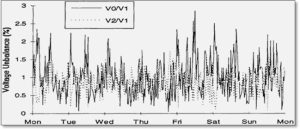
The cause of voltage unbalance is as follows:
- Unbalanced polyphase loads, e.g. capacitor banks and motors.
- Due to voltage unbalance, an Interruption in the 3-phase operation occurs.
8) Noise
Noise is a high-frequency distortion of the voltage waveform which is mostly unnoticed.

The causes of noise are as follows:
- Power electronic devices
- Control circuits, arcing equipment
- loads with solid-state rectifiers, and switching power supplies
Due to noise, the disturbance in electronic devices will happen (such as microcomputers and programmable controllers).
The below table shows the standards used for the classification of power quality events.
If you are looking for solution to these power quality events
Visit us https://ieng.tech/power-quality-solution-1/
Having queries or looking for consultation, then feel free to contact us at vaibhav@iengaust.com.au


